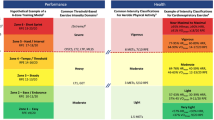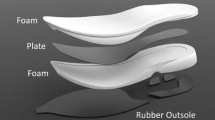Summary
-
1.
Step, bicycle and treadmill tests for the prediction of aerobic work capacity have been compared in ten young men.
-
2.
The efficiency of performance of a simple step test at a comfortable speed was independent of step height (over the range 9 to 18 inches). Efficiency was reduced at low and at high rates of stepping. On the bicycle ergometer efficiency was independent of load over the range 384 to 960 kg.m./min. Individuals with a large aerobic capacity were less efficient in the performance of both tasks; this was apparently attributable to unmeasured anaerobic components of metabolism.
-
3.
The oxygen consumption at a given rate of external work decreased in step, bicycle, and treadmill tests, as each task was learnt. The oxygen consumption during the first definitive test of each type could be predicted from the work rate without systematic error. The variance of this prediction decreased with learning, but remained consistently greater for the treadmill than for step and bicycle tests.
-
4.
Whether the ‘work’ or the oxygen consumption scale of the Åstrand nomogram was used to predict aerobic work capacity, the variance of the discrepancy between predicted and directly measured values was marginally smaller for the step test than for the bicycle ergometer; it was also smaller than for the treadmill test. On grounds of reliability and convenience, the step test thus seems the method of choice for the prediction of aerobic work capacity.
-
5.
With all three test procedures, the aerobic work capacity could be predicted with a much smaller coefficient of variation if the oxygen consumption used in this prediction was measured rather than estimated from the work rate.
Similar content being viewed by others
References
Asmussen, E., E. H. Christensen u.M. Nielsen: Die Bedeutung der Körperstellung für die Pulsfrequenz bei Arbeit. Skand. Arch. Physiol.81, 225–233 (1939).
—, andS. V. Molbeck: Methods and standards for evaluation of the physiological working capacity of patients. Comm. Testing and Obst. Inst., Hellerup, Denmark, No. 4. (1959).
—, andM. Nielsen: The regulation of the body temperature during work performed with the arms and with the legs. Acta physiol. scand.14, 373–382 (1947).
Åstrand, I.: The physical work capacity of workers 50–64 years old. Acta physiol. scand.42, 73–86 (1958).
—,P.-O. Åstrand andA. Stunkard: Oxygen intake of obese individuals during work on a bicycle ergometer. Acta physiol. scand.50, 294–299 (1960).
Åstrand, P.-O.: Experimental studies of physical working capacity in relation to sex and age. Copenhagen: Munksgaard 1952.
—, andI. Ryhming: A nomogram for the calculation of aerobic capacity (physical fitness) from pulse rate during submaximal work. J. appl. Physiol.7, 218–221 (1954).
—, andB. Saltin: Maximal oxygen uptake and heart rate in various types of muscular activity. J. appl. Physiol.16, 977–981 (1961).
Bobbert, A. C.: Physiological comparison of three types of ergometry. J. appl. Physiol.15, 1007–1014 (1960).
Christensen, E. H.: Beiträge zur Physiologie schwerer körperlicher Arbeit. Arbeitsphysiologie4, 154–174 (1931).
—, u.O. Hansen: Zur Methodik der respiratorischen Quotient-Bestimmungen in Ruhe und bei Arbeit. Skand. Arch. Physiol.81, 137–151 (1939).
Cotes, J. E., andF. Meade: Physical training in relation to the energy expenditure of walking and to factors controlling respiration during exercise. Ergonomics2, 195–206 (1959).
— —, andM. E. Wise: Variations in the vertical work done against gravity and in the energy expenditure of walking, between men and women and in relation to training. J. Physiol. (Lond.)141, 28–29 p (1958).
De Moor, J. C.: Individual differences in oxygen debt curves related to mechanical efficiency and sex. J. appl. Physiol.6, 460–466 (1953).
Dempsey, J. A.: Ph. D. Thesis, University of Wisconsin, Madison, Wisc., U.S.A. (1965).
Glaser, E. M.: The physiological basis of habituation. Oxford, England: Oxford University Press 1966.
Glassford, R. G., G. H. Y. Baycroft, A. W. Sedgwick, andR. B. J. MacNab: Comparison of maximal oxygen uptake values determined by predicted and actual methods. J. appl. Physiol.20, 509–513 (1965).
Goodwin, J. E., andP. Levitt: Telemetering heart rate during exercise. Proc. Can. Fed. Biol. Soc.5, 45 (1962).
Henry, F. M., andJ. De Moor: Metabolic efficiency of exercise in relation to work load at constant speed. J. appl. Physiol.2, 481–487 (1950).
Krogh, A., andJ. Lindhard: The relative values of fat and carbohydrate as sources of muscular energy. Biochem. J.14, 290–363 (1920).
Margaria, R., H. T. Edwards, andD. B. Dill: The possible mechanisms of contracting and paying the oxygen debt to the role of lactic acid in muscular contractions. Amer. J. Physiol.106, 689–715 (1933).
—,P. Cerretelli, P. Aghemo, andG. Sassi: Energy cost of running. J. appl. Physiol.18, 367–370 (1963).
Mellorowicz, H.: Chairman of symposium on the standardization of ergometry. 16th World Congress of Sports Medicine, Hannover (1966).
Nagle, F. J., B. Balke, andJ. P. Naughton: Gradational step tests for assessing work capacity. J. appl. Physiol.20, 745–748 (1965).
Robinson, S.: Experimental studies of fitness in relation to age. Arbeitsphysiologie10, 251–323 (1938).
Ryhming, I.: A modified Harvard step test for the evaluation of physical fitness. Arbeitsphysiologie15, 235–250 (1953).
Shephard, R. J.: The prediction of ‘maximal’ oxygen consumption using a new progressive step test. Ergonomics (in press). (1966a).
—: Initial ‘fitness’ and personality as determinants of the response to a training regime. Ergonomics9, 3–16 (1966b).
—, andR. L. McClure: The prediction of cardiorespiratory fitness. Arbeitsphysiologie21, 212–223 (1965).
Strom, G.: The influence of anoxia on lactate utilisation in man after prolonged muscular work. Acta physiol. scand.17, 440–451 (1949).
Weiner, J.: International Biological Programme: Guide to the human adaptability proposals. I.C.S.U. Special committee for the International Biological Programme, 1965.
Author information
Authors and Affiliations
Rights and permissions
About this article
Cite this article
Shephard, R.J. The relative merits of the step test, bicycle ergometer, and treadmill in the assessment of cardio-respiratory fitness. Int. Z. Angew. Physiol. Einschl. Arbeitsphysiol. 23, 219–230 (1966). https://doi.org/10.1007/BF00693686
Received:
Issue Date:
DOI: https://doi.org/10.1007/BF00693686




